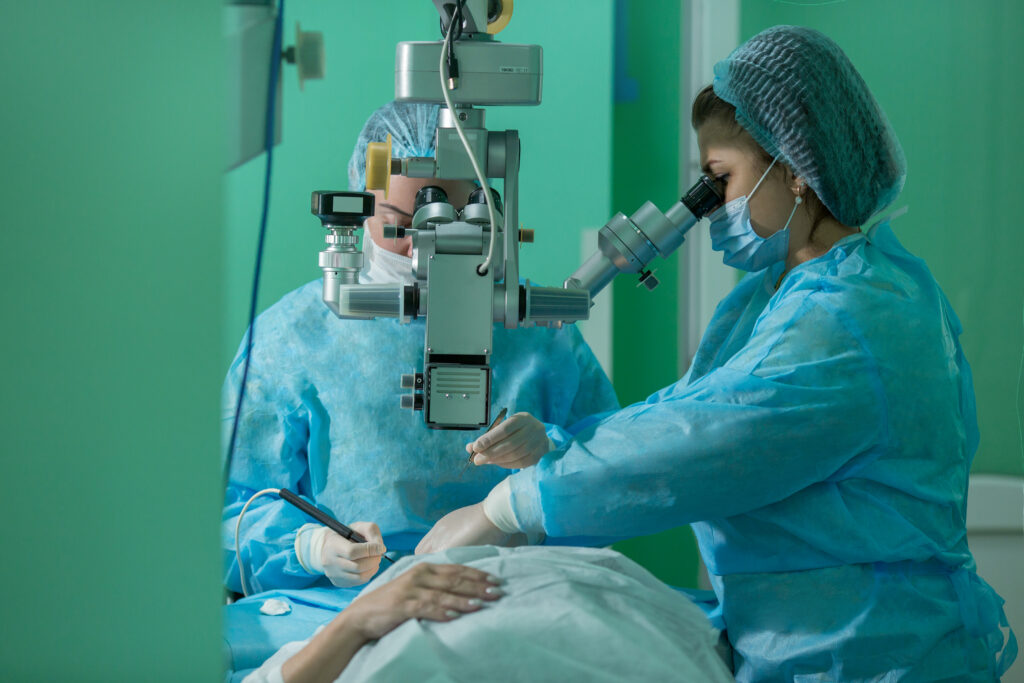Reviewed By: Bradley Middaugh, O.D.
The cornea, a clear dome-shaped surface at the front of your eye, is vital to overall vision. It protects the structures inside the eye, contributes to the refractive power of the eye, and focuses light rays on the retina.
However, its lack of blood supply makes it highly susceptible to infections, which could lead to severe complications like vision loss if not promptly and adequately addressed. This is why understanding the symptoms and effective cornea treatments is crucial.
Corneal Infection Causes
While the cornea has its defenses, several factors can lead to corneal infections:
Bacteria
Bacterial infections often surface due to poor contact lens hygiene or a foreign object scratching the cornea. Common bacteria include Staphylococcus aureus and Pseudomonas aeruginosa.
Viruses
Some viruses like the herpes simplex virus (responsible for cold sores) or the varicella-zoster virus (cause of chickenpox and shingles) can lead to corneal infections.
Fungi
Fungal corneal infections, or keratitis, often occur due to an injury inflicted by plant material such as a stick or thorn or poor contact lens hygiene.
Amoebas
Acanthamoeba keratitis, a rare but serious corneal infection, is caused by a microscopic amoeba found in nature. This often happens when using tap water to clean contact lenses.
Factors weakening the cornea’s defenses include prolonged or incorrect use of contact lenses, previous or existing eye diseases, and trauma to the eye, amongst others. Understanding these causes helps identify potential risk factors and encourages proactive measures for cornea treatments.
Corneal Infection Symptoms and Diagnosis
Recognizing the symptoms of a corneal infection is the first step in finding appropriate cornea treatments. The symptoms can vary significantly based on the cause of the condition, but the following are the most common:
Pain and discomfort
This can range from mild irritation to severe pain in the eye.
Light sensitivity
Infected corneas often result in a heightened sensitivity to light, which can cause discomfort.
Redness
This is a typical response to any form of irritation or infection in the eye.
Discharge
An unusual discharge from the eye could indicate an infection. The discharge’s color, consistency, and amount can give clues about the nature of the infection.
Decreased vision
A corneal infection can lead to noticeably worse vision.
If you notice any of these symptoms, seek medical attention right away. An eye doctor will perform a comprehensive eye examination to diagnose a corneal infection. In some cases, a corneal culture may be needed. This involves taking a small sample from the cornea to help identify the specific virus, bacteria, fungus, or amoeba causing the infection. Such detailed diagnosis helps administer the most effective corneal disease treatment, helping your vision in the long run.

Cornea Treatments
Corneal infections, depending on their severity and cause, can be treated using various strategies to eliminate the infection at its source and prevent future cornea damage.
Antibiotic Eye Drops
The first line of defense in treating corneal infections involves antibiotic eye drops. These eye drops are formulated to target the specific bacteria, virus, or fungus causing the infection. Your healthcare provider will instruct you on the correct dosage and frequency to ensure maximum effectiveness.
Combination Therapy
In some instances, multiple antibiotics may be used simultaneously to fight different types of bacteria. This combination therapy can be beneficial in dealing with resistant strains of bacteria, ensuring a more comprehensive cornea damage treatment approach.
Antiviral or Antifungal Medications
Antiviral or antifungal medications can be prescribed for viral or fungal infections. Just like antibiotic eye drops, these are designed to target and eliminate the specific virus or fungus causing the infection.
Corneal Transplant
A corneal transplant may be necessary in rare cases where the infection has caused significant cornea damage. This procedure involves replacing the damaged cornea with healthy donor tissue.
Early Detection and Prevention is Key
While cornea treatments are effective, early detection and prevention is the best way to stop the spread. Here are some preventative measures you can implement in your daily routine to protect your cornea:
Proper Contact Lens Use
Follow your optometrist’s guidelines for wearing and cleaning contact lenses. Never use tap water to clean your lenses or lens case, as this can be a potential source of infection. Always use the proper lens solution and replace your lens case regularly.
Protective Eyewear
Wear protective eyewear while engaging in hazardous or dust-prone activities. This reduces the risk of injury and infection.
Good Hygiene Habits
Wash your hands thoroughly before touching your eyes or handling contact lenses. This helps minimize the risk of transferring bacteria or other pathogens to your eyes.
Regular Eye Check-ups
Book regular eye appointments every one or two years to detect potential issues early and prevent them from escalating into serious infections.
Protect Your Vision Against Corneal Infections
At Center For Sight SW FL, we are committed to helping you maintain excellent eye health. Our team of healthcare professionals is equipped with the knowledge and technology to diagnose and treat corneal infections effectively. If you think you may have a corneal infection or would like to learn more about preventive eye care, reach out to us.
**Please note that the suggestions provided in this blog are for general informational purposes only and may not be suitable for your specific insurance plan and cornea needs. It is important to consult a qualified healthcare professional for personalized advice and treatment.**



